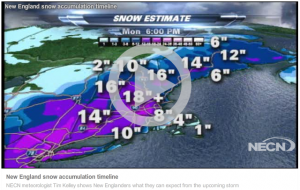 Social Media is all about finding relevant content when you need it. In the same way we share a relevant content experience when watching a movie in a theater, a weather event brings us together with our stories about the flood, ice storm, hurricane or some other shared weather event. Social media tools let you extend the shared experience and perhaps none better than Twitter. Okay, it’s more like the play-at-home version of an event and here’s how you can participate.
Social Media is all about finding relevant content when you need it. In the same way we share a relevant content experience when watching a movie in a theater, a weather event brings us together with our stories about the flood, ice storm, hurricane or some other shared weather event. Social media tools let you extend the shared experience and perhaps none better than Twitter. Okay, it’s more like the play-at-home version of an event and here’s how you can participate.
[Image Courtesy of NECN.com]
On Twitter, a way of noting an event is the use of a hashtag (or pound sign) ahead of the word that people are likely to search. For example #NewYearsEve #Snow #Blizzard or #IceStorm10. Here are some ways to play along, some even if you do not have a Twitter account:
- Determine which hashtag(s) are being used. A few quick searches on Hashtags.org will help you determine which hashtag is the most popular Twitter. For example, for a snowstorm, search #snow or #snowstorm. [Click for an example of searching snow]. It’s not unusual to see several tags develop for an event.
- Search Twitter. Use Tweetgrid.com or VisibleTweets.com and search for the “event name”. You can also just search on the word snow and see which hashtags are most used. Additional tags can also be used for state abbreviations. For example:
Looks like 2-4" per hour now #Snow #MA
Both sites allow you to search multiple hashtags.
- See if your local broadcast and ultility companies are on Twitter. Some use it well, some need to learn how. In New Hampshire, Public Service Company of New Hampshire, on Twitter as @PSNH has done a great job in updating their base since the ice storm of 2008 [related article].
- Follow The Weather. I also follow the weather radar and models directly from the National Weather Service, but the Weather Underground (wunderground.com) has some of the most user friendly ways of following for novices and experts alike.
- Add a Twitter app to your phone. If you are without power, some utilities and government organizations now use Twitter as a communications channel. Even if they don’t, you stay better informed even without power.
- Feel free to share your stories on social media, but remember, what you put on the internet is, well, on the internet.
How do you follow a storm? Please share with a comment.

